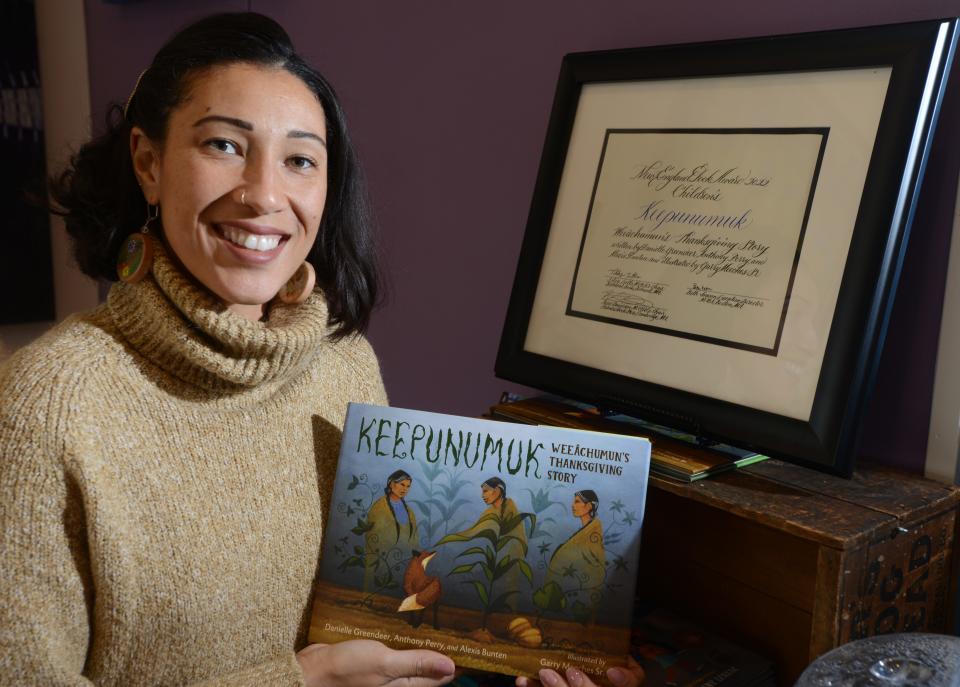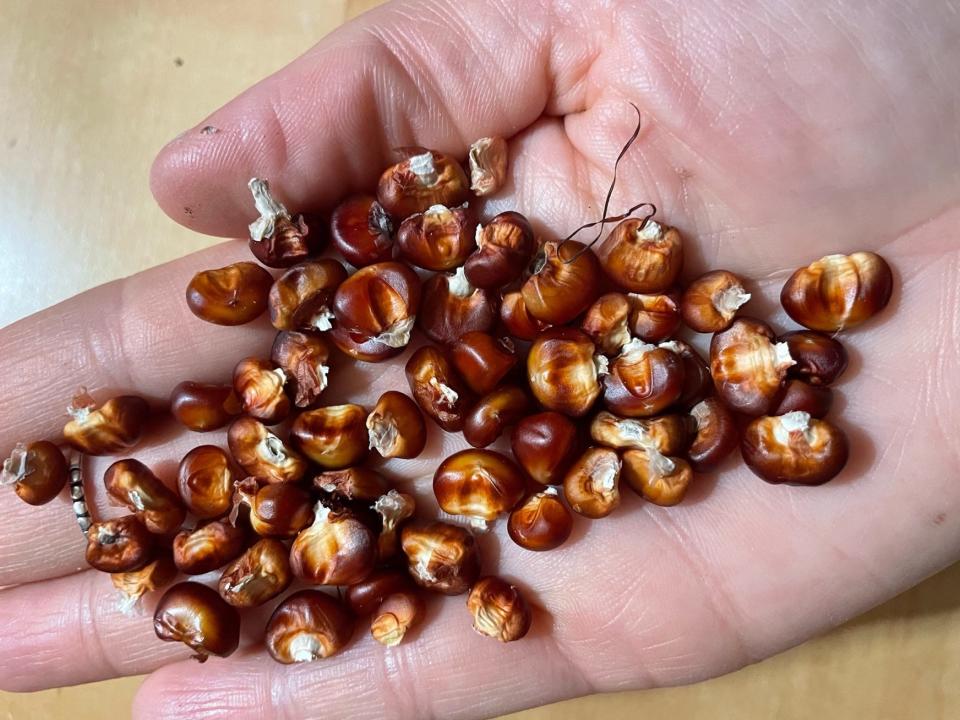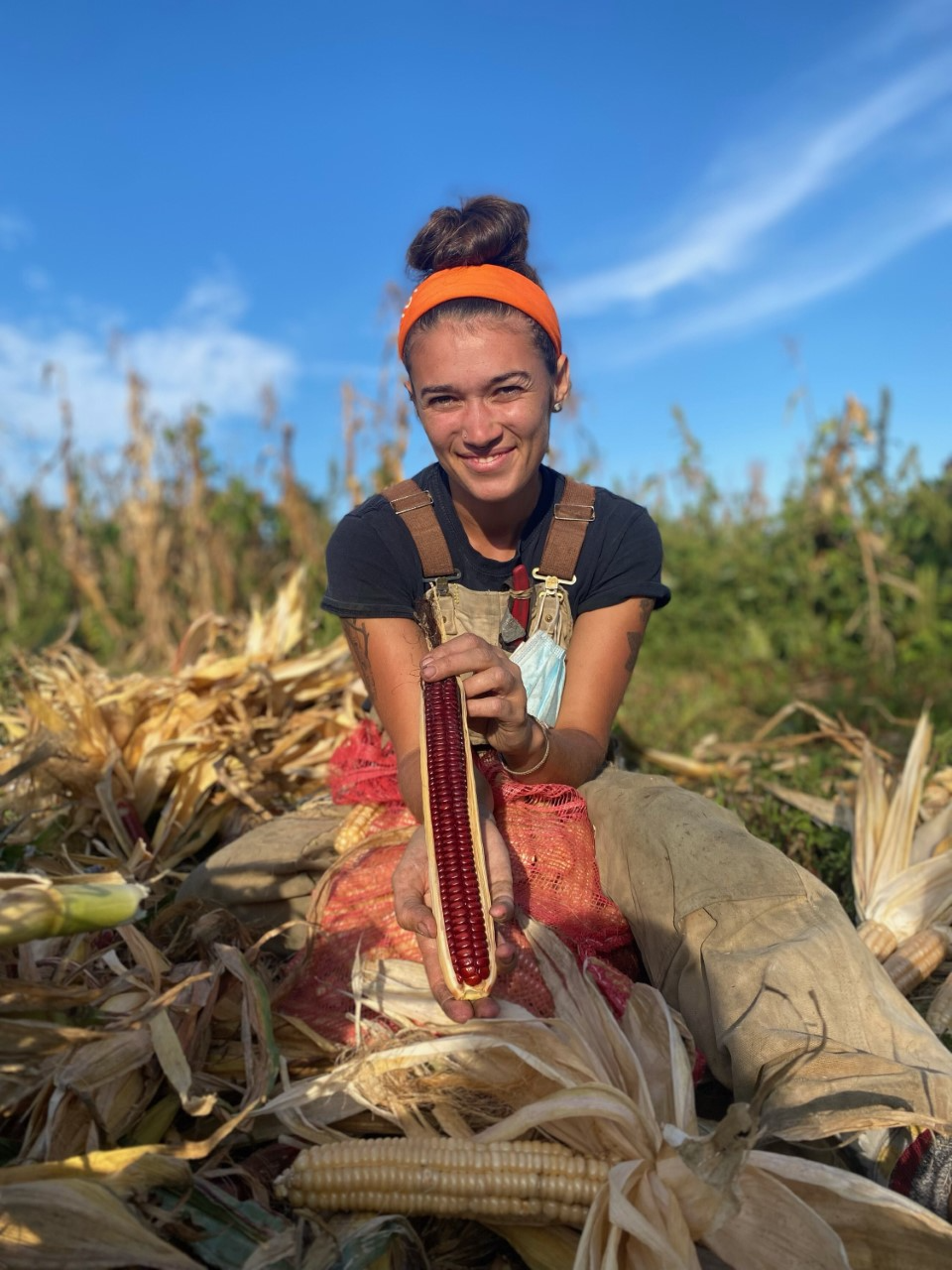Mashpee Wampanoag author reclaims history of corn, food for tribal sustenance
MASHPEE — When Danielle Greendeer, a member of the Mashpee Wampanoag Tribe, was studying midwifery in 2017, leafy stalks filled with corn began to appear in her dreams — an insight into the stages of growth, fertility, and nourishment the grain would take on in her life.
"Corn has been in the backdrop of my journey, starting as a young, Native woman," said Greendeer, owner of the Wampanoag Trading Post & Gallery in Mashpee. Greendeer refers to corn using a female pronoun.
"She will position herself for things to happen as she travels all around the world feeding and nourishing people," Greendeer said. "I've always felt that she was at work in my life."

Corn, along with beans and squash — commonly referred to as "the three sisters" within Indigenous communities, said Greendeer — are featured as main characters in Greendeer's children's book "Keepunumuk Weeâchumun's Thanksgiving Story."
The book was awarded the 2022 New England Book Award for children's books by the New England Independent Booksellers Association.
The publication, co-authored by Anthony Perry and Alexis Bunten, and illustrated by Garry Meeches Sr., centers on Weeăchumun, the Wampanoag word for corn, and the role the three sisters played in the survival of the newcomers, or the Pilgrims. The book also features plant and animal beings that contributed to Keepunumuk — which translates to "a time of harvest" in Wopanaak — the Wampanoag Tribe's original language.
Read more: First Light Shellfish Farm brings economic sustainability to Mashpee Wampanoag Tribe
In 2018, Greendeer and her co-authors were thinking about how to share a Thanksgiving story without regurgitating history told from a white man's perspective.
"We wanted to own the narrative, and take it back as Indigenous people, center it around food, and plant and animal beings," she said. "We wanted to use our common sense and dig into our genetic memory."
The book, released this year, has a recipe for nasamp, a traditional Wampanoag corn-based dish.
"Nasamp is comfort food. Historically, it was a dish that was always on the fire in the village so anyone could eat it at any point in time," said Greendeer.
Read more: What is Indigenous tattooing? In New Bedford, and Denmark, women artists revive the practice
The inclusion of nasamp in the book was to also give readers an opportunity to indigenize their holiday meals. "Indigenous food can spark conversations about Native people in general, what territory you are on, and what the real history is," said Greendeer.
Bringing corn and knowledge back into the Wampanoag fold
While she travels the country giving educational workshops, book signings and talks, Greendeer has also managed to rematriate King Philip Corn, a variety of corn, back to the Wampanoag Tribe. In tribal communities throughout the nation, seeds were often taken by settlers.
In 2016, Greendeer was able to work corn fields in Wisconsin, and learned how to grow varieties of the grain including green oaxacan, and glass gem.

"That’s when I got the firsthand experience planting it, growing it, and watching it through its stages," said Greendeer.
She also learned about mounding, a planting process used when raising corn, she said. Because the stalk roots or "feet," as Greendeer calls them, are weak, corn is grown along with beans and squash. The bean root systems help anchor stalks to the ground, and squash helps protects the soil.
"These big winds can come through, and without the mounding, and without this core of beans, and help from squash, she just flops right over," she said.
A gift of King Philip Corn to Wampanoag author prompts growing season in Mashpee
As Greendeer moved through different tribal communities growing corn, she was featured on "Gather," a documentary about the growing movement among Native Americans to reclaim their spiritual, political and cultural identities through food sovereignty. Greendeer's appearance in the film, released in 2020, prompted Owen Smith Taylor of True Love Seeds, a cultural preservation and rematriation-focused seed company, to gift heirloom Wampanoag corn seeds, also known as King Philip Corn, to Greendeer.
"It was right around that time that we moved home to Mashpee and here she comes again, saying, 'You've gotten some practice with these other corns. Now it's time to bring me back to Mashpee,'" said Greendeer, referring to the corn.
For two seasons Greendeer has been growing the eight-row flint corn that originated in Central and South America about 7,000 years ago. At some point, the seeds made their way north through ancient Indigenous trading and communal networks, she said. When the stalks were harvested and dried, Greendeer said she was in awe of the crimson, burgundy, and deep orange kernels.
Read more: 'Wampanoag Pilgrim Disney'?: Wampanoag Tribe severs ties with Plimoth Patuxet Museums
Throughout each season, Greendeer taught Wampanoag Tribe members how to grow the corn, and also about its origins.
"For thousands of years, there’s been a symbiotic relationship between corn and humans, which is spiritual," she said. "Corn can't survive without both parties, which creates this amazing relationship."
Stewardship crosses tribal territories throughout Massachusetts
Corn is also finding other stewards to keep her alive.
Keely Curliss, a member of the Hassanamisco Band of Nipmucs, a state recognized tribe, also found her way to an eight-row white flint corn in her dreams. In the reverie, she said her ancestors asked her to bring the variety of corn back to the tribe.
"I paid attention when that dream happened and I got my hands on seeds from government seedbanks," she said.
Curliss, who is entering her 15th growing season, works on rematriation efforts in central Massachusetts with the Farm School, and is transitioning 188 acres of private land back to the Nipmuc Tribe.
Many times the only way to be reunited with traditional seeds is to go through a government agency, Curliss said. Throughout colonization, settlers in a given area would steal or receive seeds from Native neighbors. For hundreds of years, farmers kept the seeds, often submitting them to governmental seed banks.

"It's sad because they never think about allowing the community themselves to tend to those seeds," she said.
Other ways that tribal members are reunited with traditional seeds is through archaeological digs, said Curliss. Ancient Hassanamisco Nipmuc squash seeds, which are hundreds of thousands of years old, recently fell into Curliss' hands, and germinated at several farms in Western Massachusetts. As she and her team grew the squash, they weren’t sure what it would look or taste like.
"Was it supposed to be a harder winter squash ? We didn't know," she said. "We had to pay attention to the plant and learn from the plant."
The seeds hold thousands of years of genetic memory, said Curliss, and every year they are planted they become older, and wiser, and remember what each season gives to the plant. That's why it's so important for heirloom and traditional seeds to be carried on.
"Our flesh dies, but the next generation picks it up and keeps going," she said. "Corn and squash — they are old relatives with an old memory. There's reciprocity there and eventually it's their turn to nourish us."
Food sovereignty efforts across tribal territories
As Curliss re-cultivates her relationship with Hassanamisco Nipmuc squash, and flint corn, she said her knowledge surrounding food sovereignty also strengthened.
Food sovereignty is about power, control and participation within a food system that's culturally appropriate to a group of people. The importance, she said, is for that food system to be healthy — not only for the consumer — but for the planet, the earth, and the people who are growing, raising and processing food.
"For generations, our ancestors were able to live harmoniously in relationship with the land that was feeding them," she said. "Through colonization, and through the ways we have been severed from our land, the intimacy of that relationship has been damaged."
Greendeer, who teaches a Native food systems class at the University of Massachusetts Amherst Stockbridge School of Agriculture, said food sovereignty is also a legal and policy perspective on how to strengthen a tribal nation’s food economy.
Read more: Three Sisters Farmers & Crafts Market a chance for Wampanoags to be self-sufficient
"It's about gaining, buying and having land gifted, and acquiring resources so you can grow on an agricultural scale for your community," she said.
Food sovereignty can also be about developing laws on tribally-held, federal reservation lands and shifting what's acceptable and accessible to consumers, said Greendeer.
"On a larger scale, tribes that own gas stations can create a law where they won't sell potato chips, for example. Tribes are shifting, through legal avenues and tribal courts, what they want on their tribal lands," she said.
Greendeer has goals for the Wampanoag Tribe's food policy
For the Wampanoag Tribe, Greendeer said she envisions a food policy council where the tribe can take a position on food accessibility, and transform lands where growing can take place on a large scale.
"A place where we can grow fresh, organic food for tribal members for health-related reasons, then having a relationship with other municipalities and state, federal and town (governments) to fund that initiative," she said. "Food sovereignty is another avenue towards land resources but also looks like environmental and health advocacy."
A great place to discuss the many facets of food sovereignty is at the dinner table, said Curliss.
"Everyone eats most days. And so, as we eat, we are in relationship and we can make choices and changes if we want to," she said. "What's radicalized me is that there's always a new corner to turn to see where we reconnect and rebuild."
Storytelling and tribal food sovereignty go hand-in-hand
What's amazing about Greendeer's book, said Curliss, is its ability to translate stories that were shared in tribal communities for generations. As a young girl, she remembers being told the story of the first strawberry by elders and family members, an oral tradition that revolved around strawberries and their connection to Nipmuc people.
"Stories are an access point in a big way for a lot of folks and help enliven a part of your mind, brain, and heart," she said. "When you are having a hard day, you always have a story to lean on."
Stories are also a vital piece of food sovereignty's continuity, she said.
"At the many stages of growing food, we are bringing the youngest little ones into that process," she said. "The intergenerational aspects of food work is the only thing that will keep it going."
Seeing corn as gift-giving, a help
Corn can be a bridge that keeps the flow of knowledge going for generations, Greendeer said. For thousands of years there were corn societies, corn rituals and corn ceremonies among diverse tribal communities, she said.
"When community pays attention to corn and reveres her in a God-like way with prayer and rituals, she will gift the community the things we need to continue the cultural revolution," she said. "It's about tapping into the ancestors, intuitive energy, and being receptive and doing the work."
In "Keepunumuk," corn leads the way through plague and colonization to feed the hungry settlers, who most likely would have died if they were left alone. But corn doesn't discriminate, said Greendeer. "Weeachumun's goal is to feed people. She just wants to help."
"At that time, tribal people were relocating, and corn needs help to grow. The settlers were hungry. Corn says, 'Just feed them,'" Greendeer said. "Corn doesn't care what you look like or where you're from. That's where the compassion comes in. The unity. The story is always told that it was the Pilgrims versus the Indians. But it was about food. And corn would never let you starve."
Gain access to premium Cape Cod Times content by subscribing.
This article originally appeared on Cape Cod Times: Mashpee Wampanoag author works to reclaim corn for tribal sustenance

